In the long history of local colleges and prep schools, TCU, TWU, the seminary, and UTA are rare survivors. Far more such schools failed than succeeded.
Here are four.
Fort Worth Industrial and Mechanical College
 The Black Baptist Missionary and Educational Convention founded Hearne Academy for African-American students in Robertson County in 1881. In 1882 the cornerstone was laid by the grand master of the International Order of Odd Fellows.
The Black Baptist Missionary and Educational Convention founded Hearne Academy for African-American students in Robertson County in 1881. In 1882 the cornerstone was laid by the grand master of the International Order of Odd Fellows.
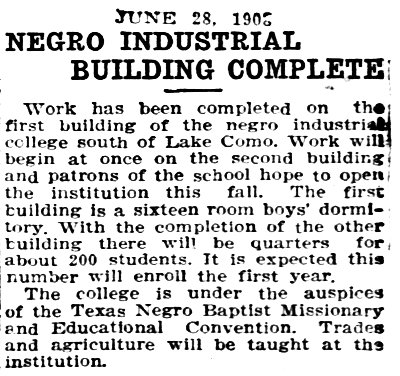 In 1909 the academy moved to Fort Worth, where it continued as “Fort Worth Industrial and Mechanical College.”
In 1909 the academy moved to Fort Worth, where it continued as “Fort Worth Industrial and Mechanical College.”
The Fort Worth Telegram reported that ten acres for a campus had been donated south of Lake Como in Arlington Heights and that another one hundred acres had been bought for truck farming. At that time the center of African-American life in Fort Worth was on the east side of downtown and east Fort Worth, although the Lake Como area had a small African-American enclave, many of which worked domestically for affluent whites of the West Side.
The college offered college-preparatory and industrial and mechanical courses. But it also offered domestic science courses to prepare female graduates for “household work.”
The Telegram wrote: “One of the special purposes of the proposed school is the training of young girls and young women for household work, and that is of vital interest to the people of Arlington Heights. They, more than any of the other dwellers in Fort Worth, are troubled about help for household work. The girls in training at the industrial school could leave the school in time to do much of the housework before the 9 o’clock school hour and return to their housework duties after the close of school, at 3 o’clock in the afternoon.”
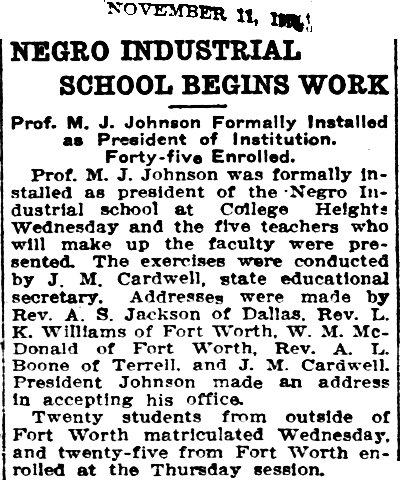 When the college opened in 1909 forty-five students had enrolled. By 1911 the enrollment was ninety-six.
When the college opened in 1909 forty-five students had enrolled. By 1911 the enrollment was ninety-six.
(The “College Heights” referred to was actually University Heights. Arlington Heights developer Humphrey Barker Chamberlin at one time had hoped to persuade Fort Worth University to relocate from the near South Side to Arlington Heights and platted the University Heights addition to accommodate a campus that never came.)
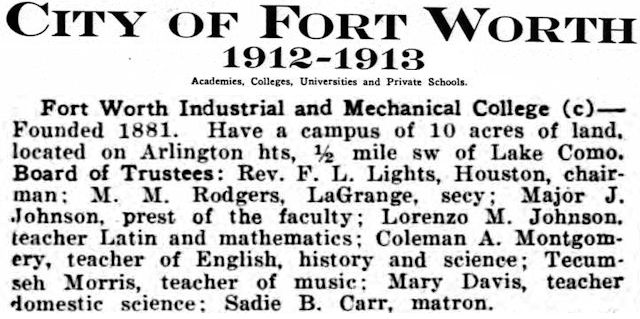 The “Founded 1881” refers to the founding of Hearne Academy.
The “Founded 1881” refers to the founding of Hearne Academy.
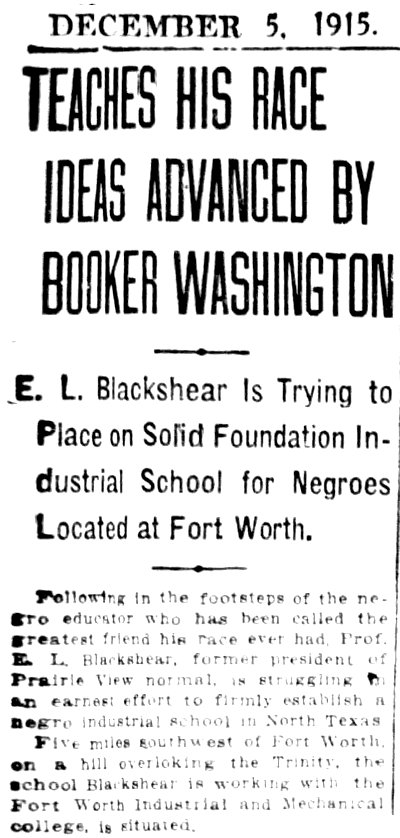 In 1915 E. L. Blackshear resigned as principal of Prairie View Normal and Industrial College for African Americans and became president of Fort Worth Industrial and Mechanical College.
In 1915 E. L. Blackshear resigned as principal of Prairie View Normal and Industrial College for African Americans and became president of Fort Worth Industrial and Mechanical College.
Blackshear continued the college’s emphasis on training students for domestic work: “As long as I am connected with the Industrial and Mechanical College of Fort Worth I am going to see that the boys are encouraged to work for the white people residing in Arlington Heights. . . . The students should be encouraged to go out and earn money.”
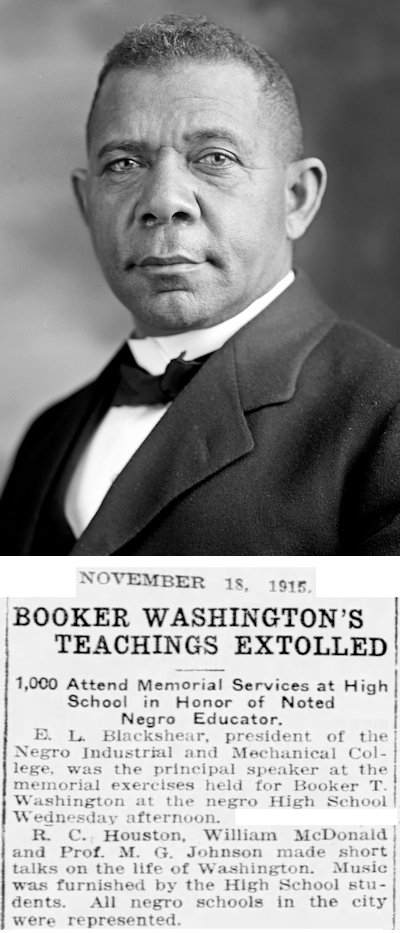 After Booker T. Washington (pictured) died, Blackshear was principal speaker at a memorial service. Also speaking were William Madison (“Gooseneck Bill”) McDonald and undertaker R. C. Houston.
After Booker T. Washington (pictured) died, Blackshear was principal speaker at a memorial service. Also speaking were William Madison (“Gooseneck Bill”) McDonald and undertaker R. C. Houston.
But Blackshear did not stay in Fort Worth long. By 1916 he was principal of Texas Normal Industrial Institute for Colored Youth in Dallas. By 1919 Blackshear was back at Prairie View.
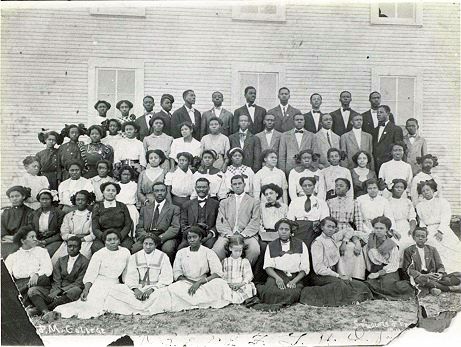 Students and faculty of the Industrial and Mechanical College of Fort Worth. (Photo courtesy of Tarrant County Archives.)
Students and faculty of the Industrial and Mechanical College of Fort Worth. (Photo courtesy of Tarrant County Archives.)
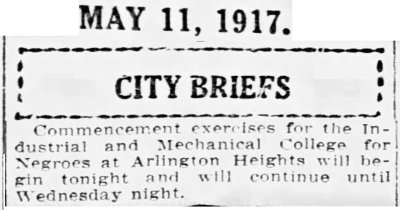 The college graduated a class in 1917, but by 1918 the college was not listed in the city directory or mentioned in local newspapers. According to William H. Wilburn, editor of Como Weekly, the college moved to Houston. It closed in 1929.
The college graduated a class in 1917, but by 1918 the college was not listed in the city directory or mentioned in local newspapers. According to William H. Wilburn, editor of Como Weekly, the college moved to Houston. It closed in 1929.
(Thanks to Bud Kennedy for the tip.)
Arlington Heights Female College
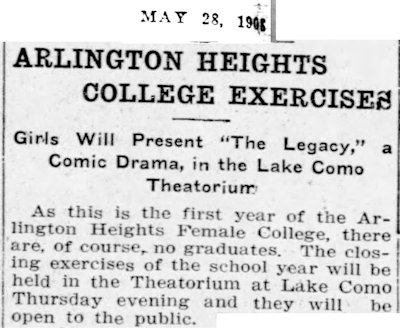 In May 1908 Arlington Heights Female College held the closing exercises of its first semester. The college was located east of Lake Como trolley park.
In May 1908 Arlington Heights Female College held the closing exercises of its first semester. The college was located east of Lake Como trolley park.
An ad for the college proclaimed: “Arlington Heights College, a high-grade school for girls, is located at Arlington Heights, a beautiful suburb of Fort Worth. This charming place is situated on one of the highest points in Eastern [sic] Texas. It towers above the surrounding regions, and is entirely free from the smoke and dust of the city and any malarial influence that might exist. . . . An ideal place for a girl of fine constitution to study and keep well, and for the delicate girl it is all that could be desired. . . . Not necessary to send your daughters north or east. They can be educated here, under the best methods.”
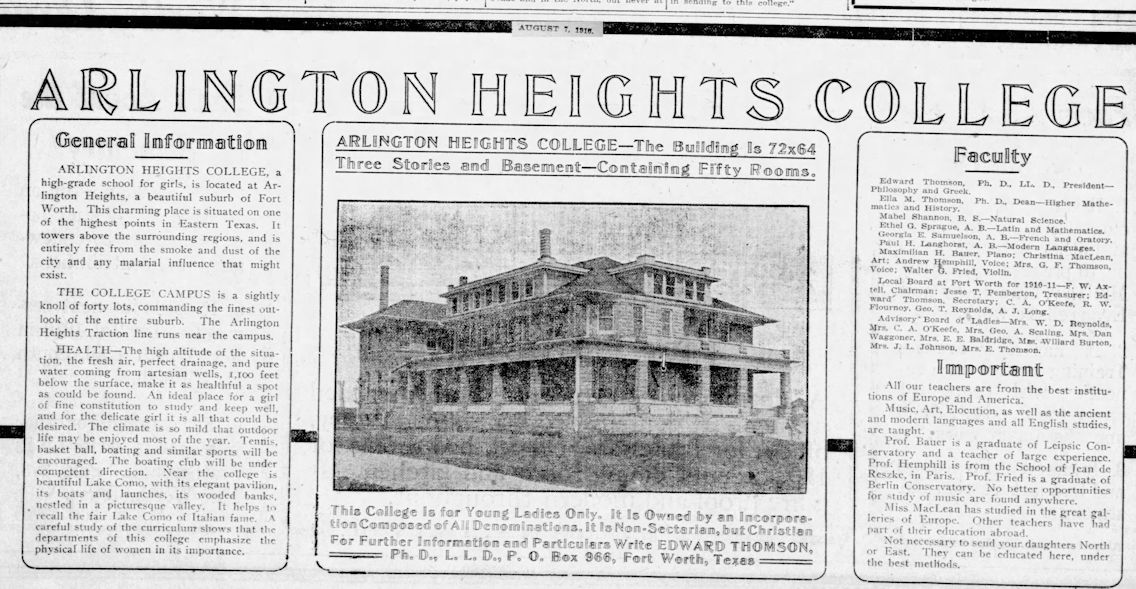 The enrollment was limited to fifty students. Students included Nenetta Burton Carter, a daughter of Robert McCart, and three daughters of C. A. O’Keefe.
The enrollment was limited to fifty students. Students included Nenetta Burton Carter, a daughter of Robert McCart, and three daughters of C. A. O’Keefe.
The Star-Telegram wrote of the college’s policies: “One or two churches will be selected as places of worship for each session. All students except Jewesses must attend church on Sunday morning, attended by teachers. Boarders will not be allowed to correspond with anyone but near relatives. All mail will be inspected by the president. A regular time will be set apart for receiving callers. Teachers and pupils will entertain at the time specified.”
 The college had five teachers. C. A. O’Keefe was a member of the school’s board of directors.
The college had five teachers. C. A. O’Keefe was a member of the school’s board of directors.
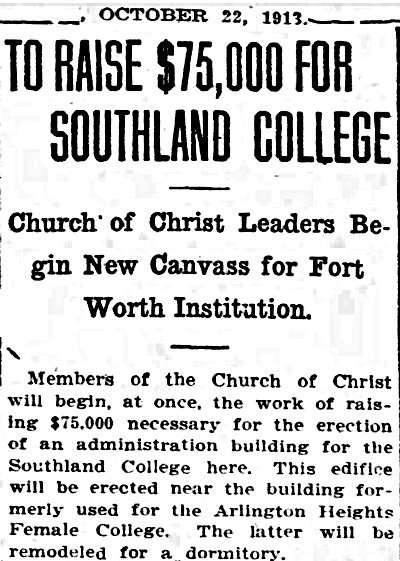 But Arlington Heights Female College closed in 1912. In 1913 the Church of Christ of Texas announced plans to buy the college and erect on the land new buildings for its Southland University (which had been located in Denton in an earlier iteration).
But Arlington Heights Female College closed in 1912. In 1913 the Church of Christ of Texas announced plans to buy the college and erect on the land new buildings for its Southland University (which had been located in Denton in an earlier iteration).
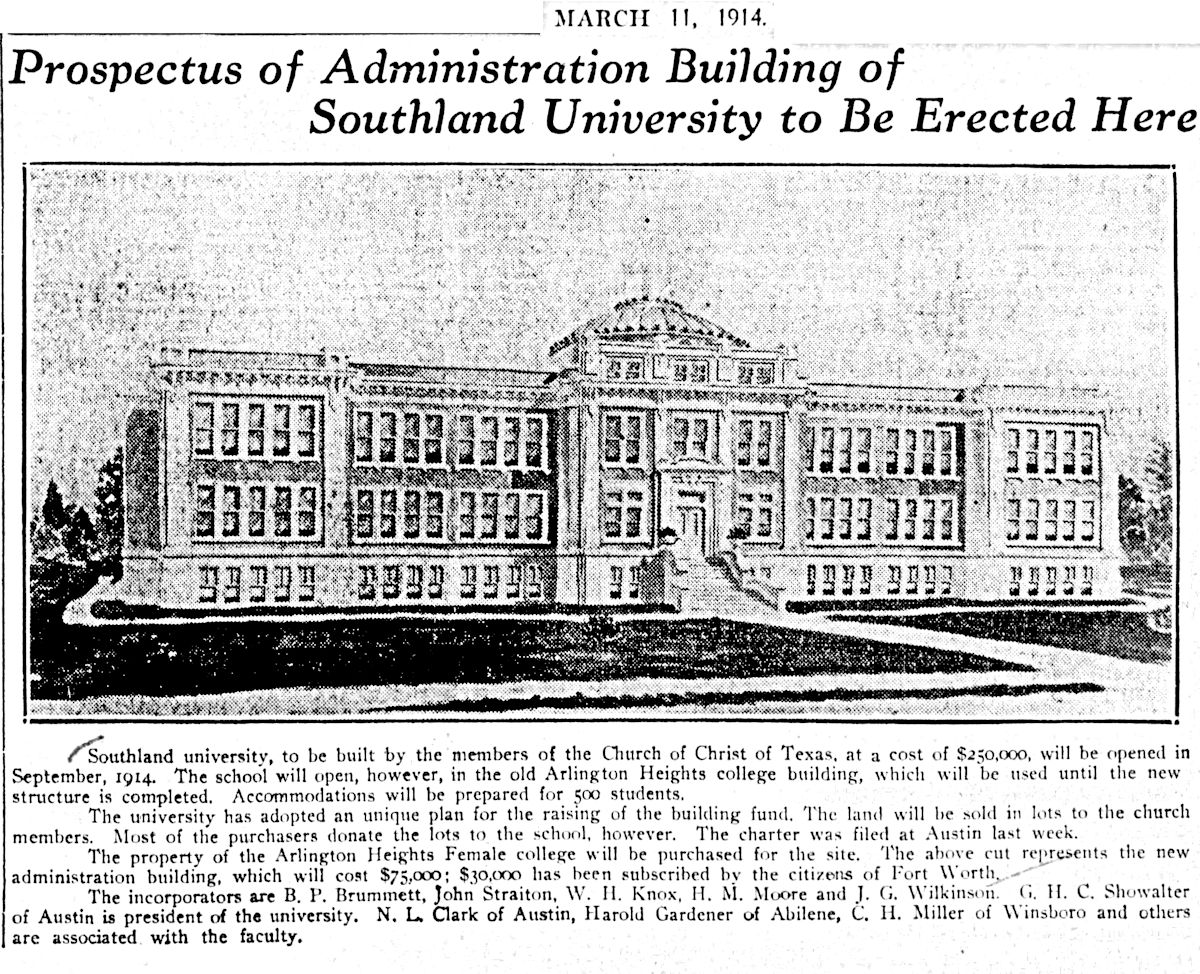 In 1914 the church presented this rendering of the proposed administration building in Arlington Heights.
In 1914 the church presented this rendering of the proposed administration building in Arlington Heights.
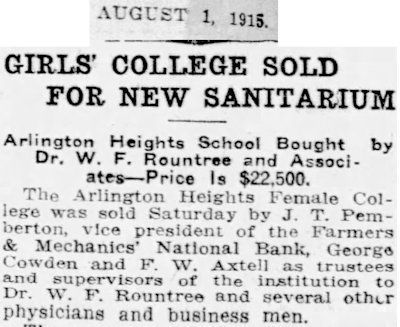 But Southland University was not to be, and in 1915 Dr. W. F. Rountree bought the Arlington Heights Female College campus to house his Southern Medical Sanitarium specializing in treatment of pellagra.
But Southland University was not to be, and in 1915 Dr. W. F. Rountree bought the Arlington Heights Female College campus to house his Southern Medical Sanitarium specializing in treatment of pellagra.
Bryant School for Boys

 In 1907 William Cullen Bryant was a history teacher at Fort Worth High School. He later was chairman of the education department at Polytechnic College.
In 1907 William Cullen Bryant was a history teacher at Fort Worth High School. He later was chairman of the education department at Polytechnic College.

 In 1912 he announced that he would open a prep school for boys in the buildings that formerly had housed Fort Worth University on Cannon Street. Enrollment would be limited for forty students.
In 1912 he announced that he would open a prep school for boys in the buildings that formerly had housed Fort Worth University on Cannon Street. Enrollment would be limited for forty students.
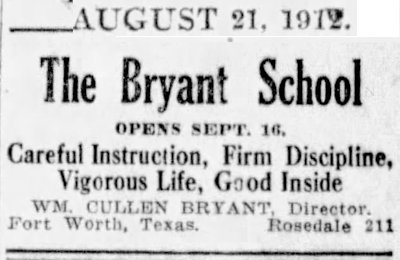 Note the “Rosedale” telephone prefix.
Note the “Rosedale” telephone prefix.
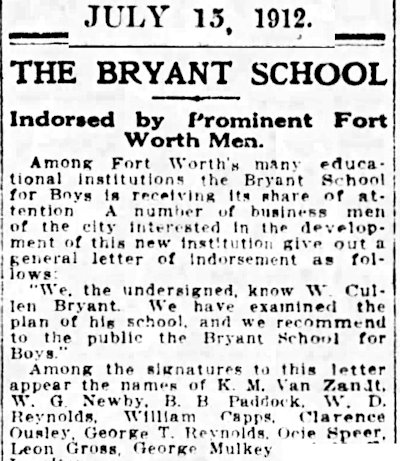 Among civic leaders endorsing the new school were Khleber Miller Van Zandt, B. B. Paddock, the Reynolds brothers, William Capps, Clarence Ousley, Leon Gross, and George Mulkey.
Among civic leaders endorsing the new school were Khleber Miller Van Zandt, B. B. Paddock, the Reynolds brothers, William Capps, Clarence Ousley, Leon Gross, and George Mulkey.
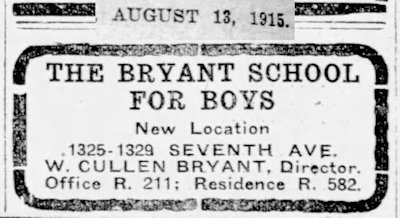 In 1915 Bryant relocated his school to 1325 7th Avenue.
In 1915 Bryant relocated his school to 1325 7th Avenue.
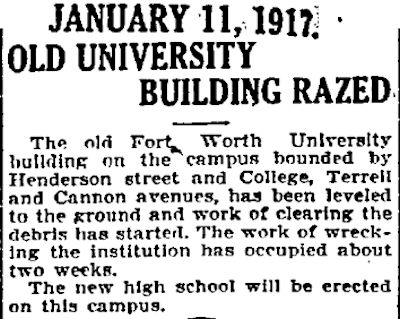 That’s because Fort Worth had bought the old FWU property on which to build its new high school (today Green B. Trimble Technical High School).
That’s because Fort Worth had bought the old FWU property on which to build its new high school (today Green B. Trimble Technical High School).
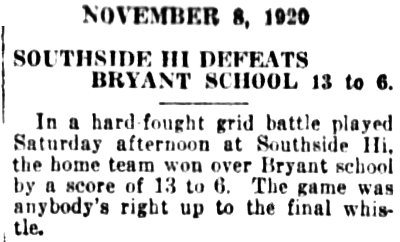 The Bryant school emphasized sports, competing with other local schools.
The Bryant school emphasized sports, competing with other local schools.
“Where was Southside Hi?” you ask. Its real name was “South Fort Worth High School.” Early in the twentieth century Tarrant County had many small school districts. One of them was South Fort Worth Common School District. In 1913 that district bought raw land west of Hemphill Street from the Interurban Land Company and in 1914 opened South Fort Worth School on West Fogg Street at Lipscomb Street. In 1922 the city of Fort Worth annexed the school district of South Fort Worth. In 1925 the school became South Fort Worth Elementary School. In 1997 the school was renamed for principal Richard J. Wilson.
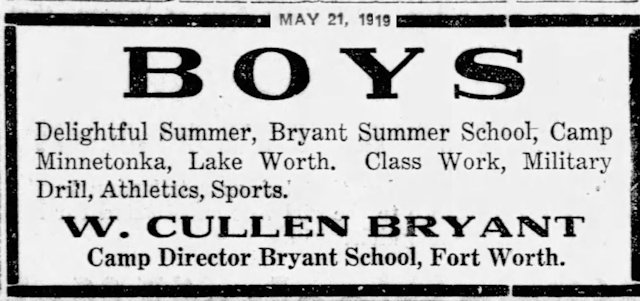 Byrant also operated Camp Minnetonka for boys at Lake Worth.
Byrant also operated Camp Minnetonka for boys at Lake Worth.
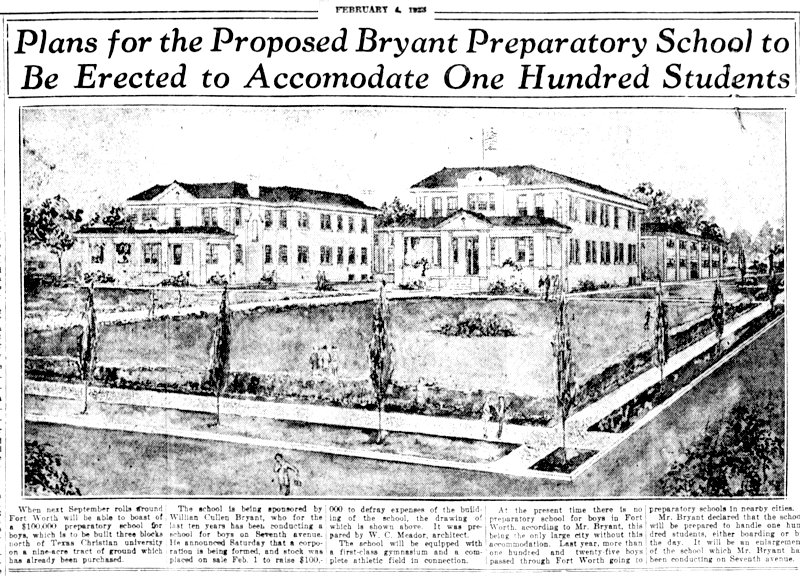 In 1923 Bryant announced that he would build a larger boys prep school just north of TCU. That plan never materialized.
In 1923 Bryant announced that he would build a larger boys prep school just north of TCU. That plan never materialized.
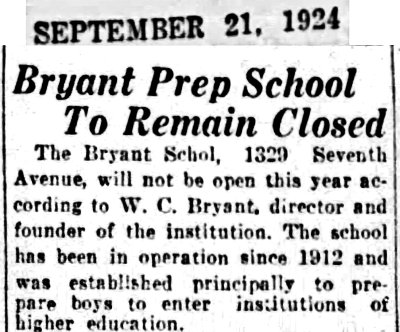 Instead Bryant School for Boys closed in 1924.
Instead Bryant School for Boys closed in 1924.
Carlisle Military Academy
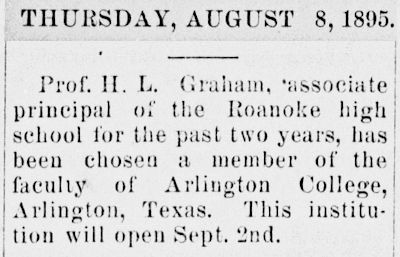 Unlike the first three schools profiled here, the fourth school was an ancestor of a school that flourishes today. Carlisle Military Academy was the second of seven schools that culminated in the University of Texas at Arlington. The first school, Arlington College, opened in 1895.
Unlike the first three schools profiled here, the fourth school was an ancestor of a school that flourishes today. Carlisle Military Academy was the second of seven schools that culminated in the University of Texas at Arlington. The first school, Arlington College, opened in 1895.
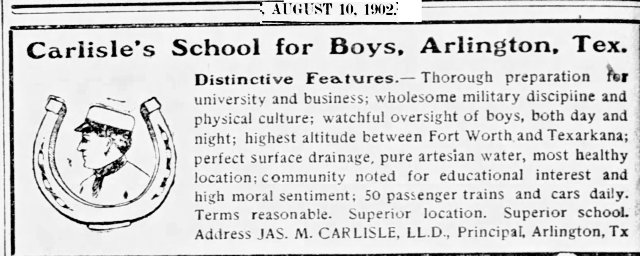 Arlington College closed in July 1902, and the campus was taken over by Carlisle Military Academy for boys. Colonel James McCoy Carlisle (1851–1922) was born in Tennessee. In 1890 he was hired as superintendent of Fort Worth public schools. In 1891 Governor James S. Hogg appointed him state superintendent of public instruction.
Arlington College closed in July 1902, and the campus was taken over by Carlisle Military Academy for boys. Colonel James McCoy Carlisle (1851–1922) was born in Tennessee. In 1890 he was hired as superintendent of Fort Worth public schools. In 1891 Governor James S. Hogg appointed him state superintendent of public instruction.
Carlisle opened Carlisle Military Academy as “a high grade preparatory school for manly boys.” Enrollment in 1902 was forty-eight students in grades five through high school.
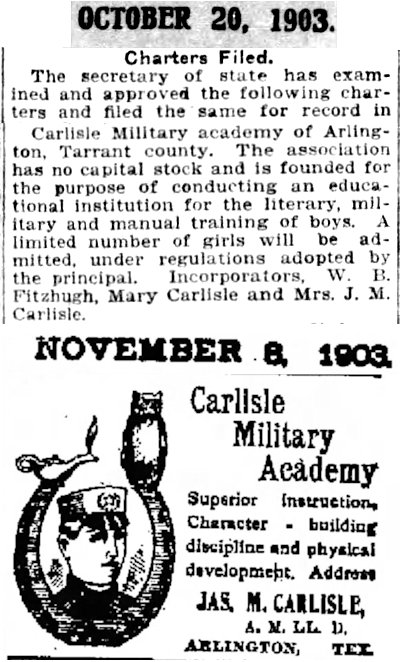 CMA was incorporated in 1903.
CMA was incorporated in 1903.
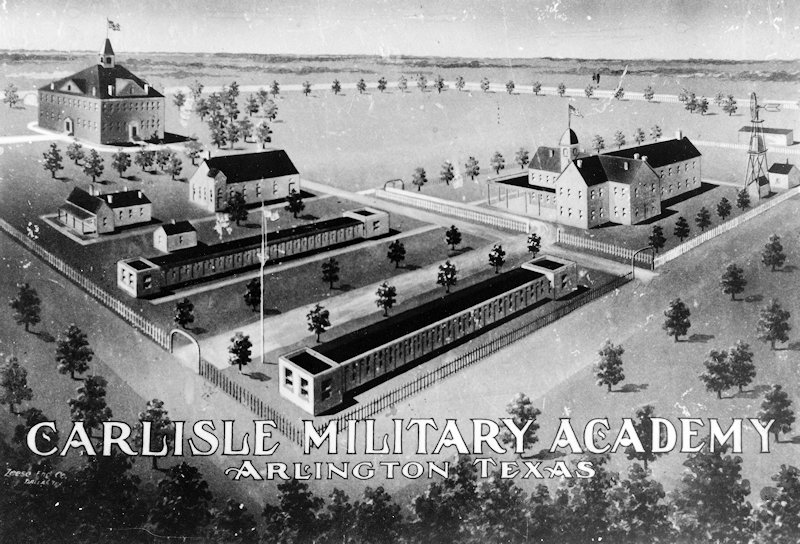
The campus covered ten acres. Cadets resided in three barracks. Cadets received instruction in general academic courses with electives such as law, science, foreign languages, and military science and tactics. Cadets received military training to prepare them for college, the U.S. Naval Academy, or the U.S. Military Academy. (Photo from University of Texas at Arlington Library.)

For one year—1904-1905—the academy accepted female students. (Photo from University of Texas at Arlington Library.)

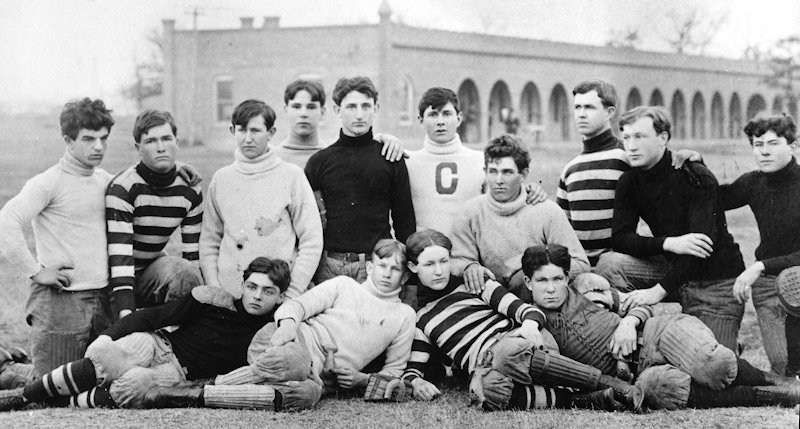
By 1906 enrollment had increased to 114. CMA emphasized sports, including football, baseball, basketball, and track and field, and competed against local colleges such as Polytechnic College. (Photo from University of Texas at Arlington Library.)
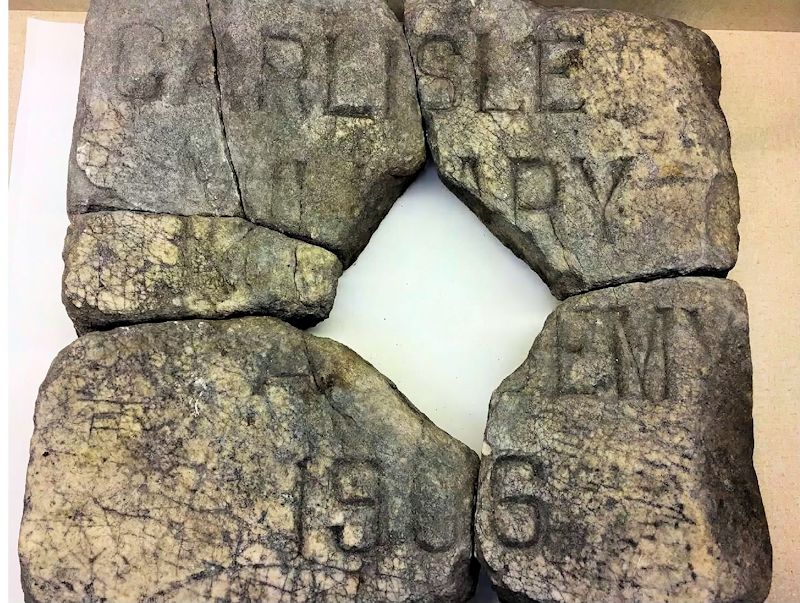 This cornerstone, dated 1906, is thought to have been used in the construction of a cadet barracks.
This cornerstone, dated 1906, is thought to have been used in the construction of a cadet barracks.
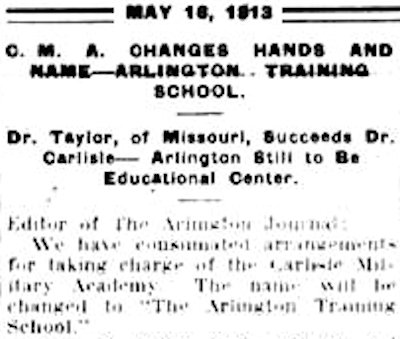 Carlisle Military Academy closed in 1913 due to lack of funds. New owners took over the campus and opened Arlington Training School.
Carlisle Military Academy closed in 1913 due to lack of funds. New owners took over the campus and opened Arlington Training School.
Here is a timeline of the schools that have occupied the campus:
1895 Arlington College
1902 Carlisle Military Academy
1913 Arlington Training School
1916 Arlington Military Academy
1917 Grubbs Vocational College, a branch of the Agricultural and Mechanical College of Texas
1923 North Texas Agricultural College
1949 Arlington State College
1967 University of Texas at Arlington, a part of the University of Texas system





